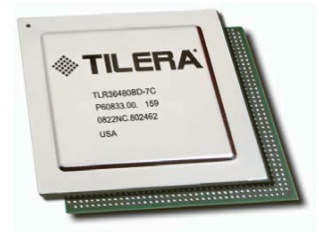MIT's 100-core CPU Will Be Ready This Year
And they're not stopping at 100, either.
Way back in October of 2009, Tilera Corp announced that it had managed to squeeze 100 cores onto a single chip. The announcement focused on a new line of multi-core processors called the TILE-Gx series. Tilera said it planned to release 16, 36, 64, and 100 core models with the goal of simplifying system architecture. So far, the company has launched the 16, 36, and 64 core models. So where's that 100 core model?
According to Wired, we don't have to wait much longer, as Tilera plans to ship the 100-core TILE-Gx later this year. Not only that, but the company's next line, code-named Stratton and set for release in 2013, will mean an expansion of cores in both directions: Tilera is claiming as few as four and as many as 200 cores for the Stratton line and a move from a 40-nm to a 28-nm process means they can cram more circuits into the same area.
Quanta is one of the manufacturers that Tilera supplies chips to, and though the servers it supplies to big-name web companies aren't powered by Tilera yet, Wired reports that the MIT-run company is on the radar of several companies. In fact, just last summer, Facebook pitted the TILE-Gx against Intel and AMD's Xeon and Opteron server-processors. The test saw a tuned version of Memcached on the 64-core Tilera TILEPro64 yielded at least 67 percent higher throughput than low-power x86 servers.
Though the social network was obviously pleased with the TILERPro64's performance, Facebook highlighted the limited amount of memory the Tilera processors support as a problem for the server chips. Thirty-two-bit cores can only address about 4GB of memory and, as Anant Agarwal, director of MIT's CSAIL (the lab behind Tilera), puts it, "A 32-bit architecture is a nonstarter for the cloud space." Tilera’s 64-bit processors are capable of supporting as much as a terabyte of memory and should more than address this problem, but Agarwal hasn't said if the improvement has been enough to sway Facebook, revealing only that Tilera and the social networking site have a good relationship.
Read more on Tilera, its 100-core chips, and its plans for future server processors, on Wired.
Further Reading:
Tilera Goes After AMD, Intel, With 100-Core CPU
Get Tom's Hardware's best news and in-depth reviews, straight to your inbox.

Jane McEntegart is a writer, editor, and marketing communications professional with 17 years of experience in the technology industry. She has written about a wide range of technology topics, including smartphones, tablets, and game consoles. Her articles have been published in Tom's Guide, Tom's Hardware, MobileSyrup, and Edge Up.
-
chickenhoagie sunflierBut will it play Battlefield 3?pshhh if my quad core can handle battlefield 3 how do you expect a 100 core to handle it? there's just no possible way.Reply
-_^ -
Give me less cores...more GHZ! I don't care what it takes. Bring back the GHZ wars!Reply
oh, and thanks in advance. -
nurgletheunclean While a good approach, it will not be mainstream. People have been asking Intel to do this for years with the original atom processor. Now that Medfield is out and can run at peek frequency at 650mw. Intel could pack 100 medfields onto a single die for a fraction of the wattage of TILE-Gx, and have full x86 compatibility at the same time. If serious demand for this kind of chip surfaced Intel's designs and processes would be far more desirable.Reply
and no it won't run BF3, or windows. -
internetlad inb4 DURR CAN'T WAIT TO PUT THAT IN MY GAMING PC from a bunch of 14 year olds who don't know what's going on.Reply
I know this because I was that 14 year old once. -
dormantreign i sorta want GHZ too. The dolphin emulator requires it and a boat load of applications run faster too with higher GHZ. Hold at 8 cores and push the GHZ envelope to around 6...then add more cores again. Rinse and repeat.Reply -
Pherule "...pitted the TILE-Gx against Intel and AMD's Xeon and Opteron server-processors"Reply
How is that for a test? They don't say how many cores the other servers had, so we can't make a real comparison here. It's no good having 100 cores if you only get a 67% performance boost over an 8-core machine.
Moreover it would help quite a few people to have 100 cores processors in desktop (non-server) machines too. I would certainly use 100 cores; I do some brute-force work as well as heavy floating point operations. Heck, I could do with a 1000 core CPU. Bring it on. -
rosen380 "higher clocks do no necessarily mean higher performance......"Reply
This. You take a P4 3.80 GHz and I'll take a Core i7-2960XM . The latter DESTROYS the former despite the difference in clock speed...
I'll take $$$ put into architecture changes that yield 10x performance improvements over the same money going towards doubling clock speeds... -
ajay_vishvanathan o.O looks like i can run a hundred counter strike 1.6 servers from my home with enough ram and internet.. :DReply
ILL BE RICH!!!! :D
btw keep it up.. reduces business costs.. saves space in servers.. this is just good.. :D
